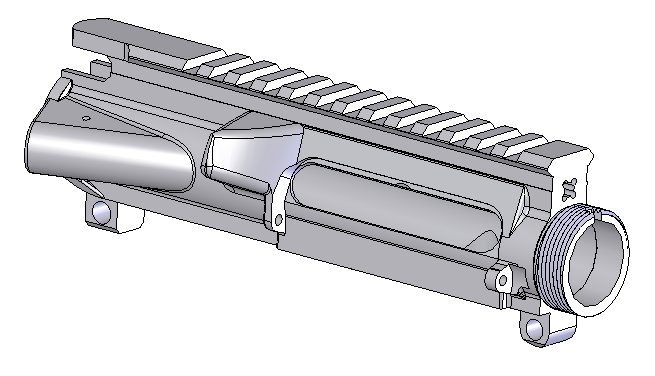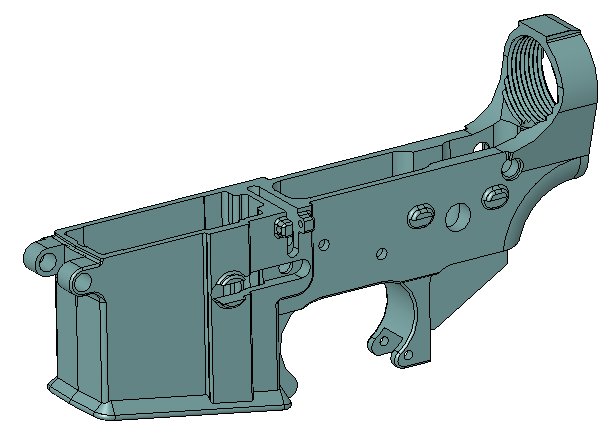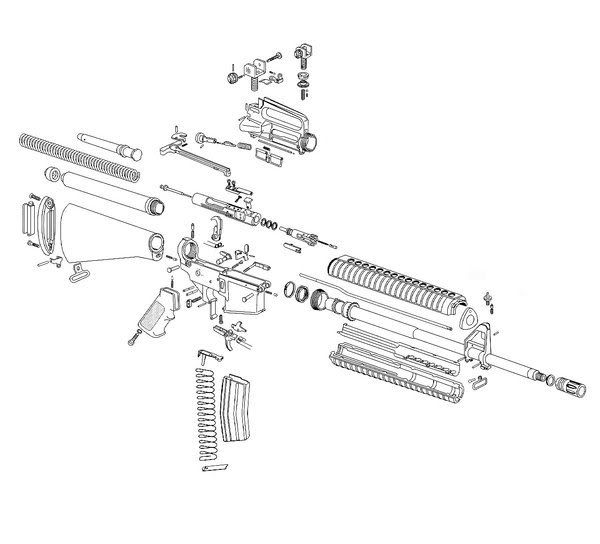Anyway. Many of you have seen images of or heard of this gun:
 |
| Image Credit: Nerf Modders Welcome/Facebook |
This is an Xplorer XEliminator, which has picked up the NIC shorthand "Xe".
A very limited production piece, with only 10 confirmed to exist, and a price tag of over $1000, US. Yeah. THAT thing.
It's a pump-action, mag-fed springer intended for NIC use, and it chronos supposedly around 250 fps.
Take a moment to note that 250 fps is not that strange for spring-piston NIC guns shooting 0.9g darts as tested, and that pump-action springers themselves are status quo, and so is a degree of endurance and reload speed consistent with magazines. Furthermore I see no evidence that, given the ballistics of the projectiles involved, there could be any massive gain in accuracy or consistency. I don't see any features to that effect.
That is all I will say in that regard, though. That has been done already.
Instead I will get to how the Xe is designed.
 |
| Image credit: NMW |
Take a very close look. It looks familiar, doesn't it?
But why is that?
Right off the bat, is resembles a breeched and pump-gripped Longshot, mechanically and even aesthetically. I made a "blender" comment on reddit about the originality of the Xe. But forget originality, it's not everything. Effective design is worth a lot more than originality and the best developments in every field are always mashups and evolutions.
No, my serious beef with this design is how it mimics the most arbitrary and problematic aspects of prior commercial Nerf guns.
Look at how complex the internal design of the receiver is.
Do each of those features need to be there? The carefully braced and stiffened, skeletonized, super thin, intricate structures everywhere, as if to minimize material use? All the unused internal volume? Screws going into these wispy little bosses standing on their own in a cavity? Why is it clamshell at all? Why is the grip integral? Why are the handguards integral?
At first I was thinking the receiver was a cast resin part, as Xplorer seems to love this prop-style methodology combined with some unidentified high-spec resin that makes strong parts... Granted many of the points raised above would STILL apply (such as those of the monolithic clamshell versus smaller, more manageable, cheaper parts that are more efficient and simpler). Also it looks extremely un-castable - but just looking at the internal-complexity issue, maybe, just maybe, it was cast and that design was to minimize material use, and there was no real cost tradeoff, the thought went...
This comment killed that thought, and returned my thinking to its original direction:
Okay, now it doesn't make ANY sense.
This is an exploded AR15.
Magazine-fed weapons of any sort, as we know them (which includes all nerf examples to date including the Xe), share fundamental mechanics, centered around the breech system's operating principle.
If you are doubting, go pull apart a Retal. Note that most of the relevant bits of a modern firearm action are there in some form, aside from the basic differences between the functionality of a firearm, and that of a spring-piston airgun.
 |
| Image credit: cncguns.com |
 |
| Image credit: cncguns.com |
The difference is clear between how the AR approaches the task of supporting and mounting all of its internal components, and how the Xe did it. It is also clear how the Xe methodology is more complex and more challenging to construct.
So that is one of my overall thoughts: We need to get the idea of a "SHELL" out of our heads and think outside the box.
Now, it is clear why the clamshell approach is appealing to the toy-grade manufacturers. They are injection-molding parts primarily from ABS. If the grip, receiver, shrouds, shells and other myriad externals can all be converted into a single clamshell set, that is only ONE set of dies and ONE machine cycle to accomplish all that. If they can use complicated structural designs inside to lightweight the part, save material and make weaker cheaper materials work, the tradeoff of having to design and fabricate molds for all that intricate internal crap pays off - because it's only molds!
But if you are going to take a "shell" design with every single stationary external bit integrated, and MILL IT FROM BAR STOCK? Holy hell!
Think about that pistol grip alone. Think of how much bigger the piece of material had to be to accomodate that. Think of how much PVC was turned into chips! All those little webs and holes and pockets in there... imagine this thing half-done on the CNC mill, and a little tiny endmill meandering around in there for hours and hours and hours to generate all that stuff! And they could have at least left it solid inside and saved the time! Most of that detail inside is nonfunctional and just makes it weaker! Why?
Had this been a monolithic-receiver design, I bet with the cost savings they could have upgraded the material to aluminum and eliminated all major plastics from the design... A more fitting spec for a thousand, dollar, mother, fragging, nerf gun!
Even disregarding the fact that with the price of the Xe one could buy a Longshot, upgrade parts, AND A SERVICEABLE CAR... I would not have bought this thing even if I was a lottery winner! Why the hell is a thousand dollar gun PLASTIC?
Come on, Xplorer. You can do better than that.
And don't forget the trigger guard.


3 days to match up...that seems a bit much to me. CNC machines are pretty good at making the same part.
ReplyDeleteI completely agree with you on the ridiculousness of the intricate bits inside the shell when they are using a solid block of PVC.
I think it costs $1000 right now is because there are so few of them, still I don't see the price ever coming down below "excessively high."
I loved the bit about the trigger guard! I was considering a water jet cut anodised aluminium +bow! with nicely radius'd edges and metric anodised fixings, but getting the parts for the actual PT etc was a pain in the UK. These are showpiece guns for the sort of people who go airsofting with mini guns in places where airsoft is legal. The other thing to note is it's still the only dedicated hobby grade blaster to date, despite it's price etc. Also worthy of note is the fact that this is Mr Hengs hobby, the factory is paid for by his other work, so PVC may have been selected on the basis of material availability and machine downtime. We should get a group together to design and manufacture our own design. Get funding off Kickstarter when the design is done. Got to be a full length k26 style springer with a pump prime as that is what the market seems to want.
ReplyDelete"We need to get the idea of a "SHELL" out of our heads and think outside the box."
ReplyDeleteI'm with you 100% on this. Us NIC homemade-builders discovered ages ago that using the plunger tube as a main structural element is simple and effective. It would seem that Xplorer was going for aesthetics quite a bit on this one, and I'll admit that the tubes-in-tubes design of most NIC homemades doesn't quite fit their apparent direction, they could save a ton of time and material cost.
I feel that their aesthetics are a function of the MilSim, type of game play that is popular over there due to airsoft and paintball being either illegal or super expensive. I believe that I read somewhere that private ownership of paintball guns was against the law in some Asian countries. As for the way the inside of the shell is made, I think that is for lightness. I love the idea of our own blaster design, and I'd be all over that for kick starter. But is it possible to do without copyright infringement? Could that be why Mr Heng only does limited runs of blasters?
ReplyDeleteThe aesthetics are definitely originated from the i.e. Singapore milsim situation you mentioned, but I would argue that the blocky Longshot-like appearance of the XEliminator detracts from realism more than anything. Just my opinion.
DeleteWhile the inside of the shell may have been intricately cleaned out to reduce weight, I don't see how the overall result is logical. It could have been heavier, but stronger and cheaper, if only some machining steps were simplified or omitted entirely and I think heavier, stronger and cheaper would be strongly preferable to nearly anyone. Similar argument could be made about the external detail and surface finish.
It appears that the MO of the Xe project was "Take a LS and throw money and fabrication resources at it until it's a luxury item" rather than designing a better dart gun for hobby use. That's what bugs me about it.
The issue of patent infringement claims against "us" in relation to clean-sheet designs of our own is often brought up and I'm not sure why. Maybe with aftermarket companies (since nerf is a field where aftermarket is not a well established presence, and aftermarket parts are necessarily derivative works to be compatible). With a scratch design, though, the idea of infringement on some random vendor's patents being unavoidable is equivalent to supposing that there is only one means to accomplish the task and alternate designs (the use of which I am advocating in this post) are impossible, which I am not inclined to believe. Particularly when the core functionality is not nerf-specific.